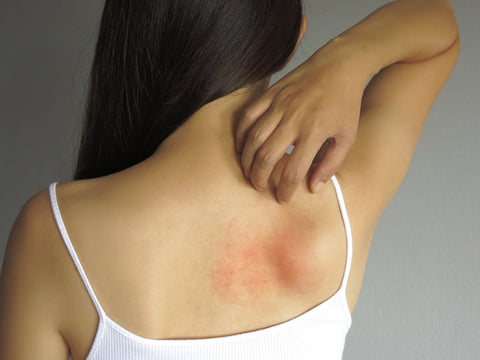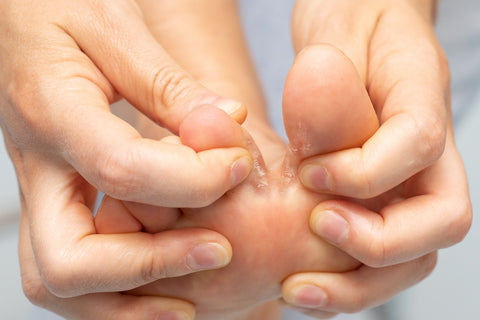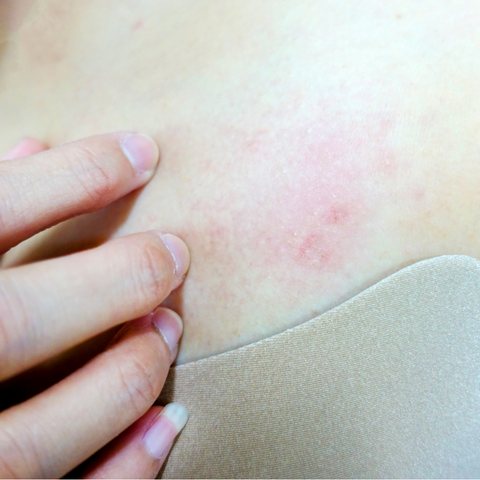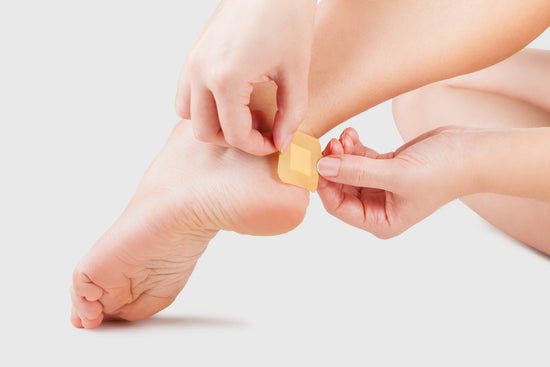MONSOON MAYHEM
It’s that time of the year when heavens open the flood gates, bringing with it much-needed respite from the torrid heat of the summers. But as with all good things, the weather shift also brings with it a wave of skin rashes and allergies. Monsoon season is the most fertile breeding season for harmful microorganisms as the showers bring down the pollutants and owing to humidity, excessive moisture, fluctuating temperatures and stagnant water, the risk of skin infections and allergens become higher in this season.
TYPES AND PREVENTIVE MEASURES
Skin problems are synonymous with monsoon season. The increased humidity levels and wetness leads to a shower of skin nuisances and decreases the skin’s ability to retain moisture. Let us take a quick look at some of the common skin problems that people experience during this weather and effective ways of preventing them –
ITCHING AND CHAFING
The most common skin irritants that affect people during this time of the year are itching and chafing. Increased humidity in the atmosphere and excessive perspiration due to heat, leads to growth of bacteria on the skin which results in itching. Chafing is typically caused by the repeated friction which generates heat and is commonly associated with pain, stinging or a burning sensation. It often occurs in the areas such as underarms, thighs, nipple area, groin and in between the legs resulting in inner thigh rash.
PREVENTION – It is essential to prevent chafing, itching and rashes as soon as they appear. These skin concerns can be treated by applying specially formulated products such as SkinEasi active Anti-chafing gel which helps in trapping moisture in your skin, gives the much-needed relief and aids in preventing inner thigh chafing, skin rashes and itching. Besides this, avoid wearing tight clothing, keep the chafe-prone areas as dry as possible, avoid scratching and most importantly practice good personal hygiene.

ATHLETE’S FOOT
It is common to experience itchy and cracked feet besides discolored toenails during the monsoon. Popularly known as Athlete’s Foot or tinea pedis, this is a common fungal infection that results from excess moisture retention or sweat due to wet socks and shoes. Athlete’s foot is caused by fungi called candida that affects skin on the feet, resulting in infection of the toenails and eventual splitting of the nail. This type of fungal infection is contagious in nature.
PREVENTION - Wash your feet with soap and water every day and pat dry them, especially between the toes. Air out your feet at home by going barefoot, wear shoes made of breathable materials. Wear socks made out of breathable fabric, and change them daily. Rotate between two pairs of shoes, wearing each pair every other day, to give your shoes time to dry out between us. During monsoon season especially, wear open footwear and use antifungal powder on your feet every day.

RINGWORM / FUNGAL INFECTIONS
Ringworm is another common monsoon fungal infection that appears in the shape of a ring and affects areas like feet, neck, armpits, scalp and groin. It causes a round, scaly, crusted patch on the skin and is characterized by itching, and blister-like lesions on the border. If scratched, it can be accompanied by tiny flare-ups on the skin and can lead to oozing.
PREVENTION - Wear clean, dry, and loose clothing in breathable fabric and steer clear of tight and damp clothes. Avoid sharing personal belongings like clothing or hairbrushes with people who might have ringworm. Maintain proper hygiene like showering and shampooing your hair regularly, keeping your feet clean and dry, and washing your hands thoroughly after interacting with an animal. Do not scratch the affected area and use anti-fungal cream and powder for relief.
ECZEMA

The most common non-contagious dermatological skin problem that affects people during this time of the year is Eczema or Dermatitis. The sudden shift from high temperatures to moist weather conditions affects the skin reducing its ability to preserve moisture resulting in eczematic skin. It is a complex inflammatory skin rash that presents clinically with a wide spectrum of symptoms. Eczema usually involves dry, inflamed, red, itchy skin mostly impacting feet, hands or lower leg. Monsoon is known to act as an agitator, increasing the condition further and the associated discomfort to a large extent. People with existing eczema or sensitive skin should be extra cautious during this season.
PREVENTION – First and foremost follow proper hygiene by taking a bath regularly. Use mild cleanser and apply a hydrating moisturizer to your skin post shower. It is important to wear clothes that are light and comfortable. Coconut oil can also be applied to the affected parts of the body to get some relief.
FOLLICULITIS

Folliculitis is a common skin condition in which hair follicles become inflamed. When a hair follicle gets infected, it tends to expand and look like a large pimple, and may also develop pus. It is usually caused by excessive sweating or long periods of moisture in a certain body part. Other reasons are ingrown hairs, shaving, tight clothing and insect bites among others. Body parts like your arms and thighs are the most susceptible.
PREVENTION – Folliculitis can be managed by preventing excessive sweating, taking regular baths and keeping the skin hydrated at times. Also, the treatment options for folliculitis depend on the type of folliculitis you have and its severity. The mild ones can be taken care by using antibacterial cleansers to clean the skin. This will limit the amount of bacteria on your skin. Apply warm towels to your irritated skin to sooth the discomfort and use anti-itch creams if needed.
Your skin needs utmost care and pampering during the rainy days. Take the right measures and consult your dermatologist for further queries.





